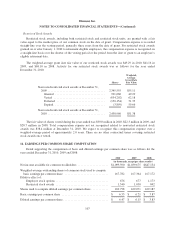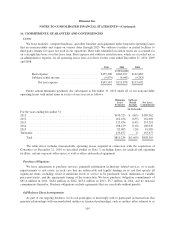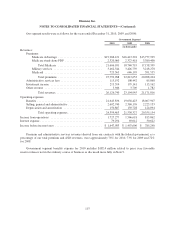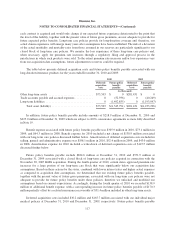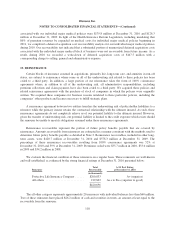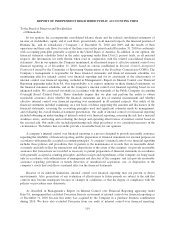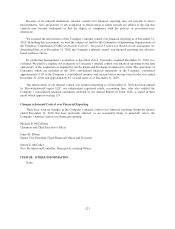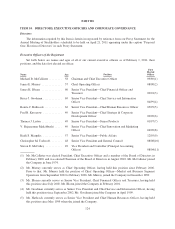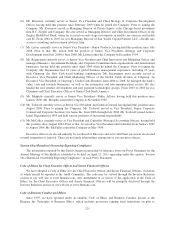Humana 2010 Annual Report Download - page 127
Download and view the complete annual report
Please find page 127 of the 2010 Humana annual report below. You can navigate through the pages in the report by either clicking on the pages listed below, or by using the keyword search tool below to find specific information within the annual report.
Humana Inc.
NOTES TO CONSOLIDATED FINANCIAL STATEMENTS—(Continued)
each contract is acquired and would only change if our expected future experience deteriorated to the point that
the level of the liability, together with the present value of future gross premiums, are not adequate to provide for
future expected policy benefits. Long-term care policies provide for long-duration coverage and, therefore, our
actual claims experience will emerge many years after assumptions have been established. The risk of a deviation
of the actual morbidity and mortality rates from those assumed in our reserves are particularly significant to our
closed block of long-term care policies. We monitor the loss experience of these long-term care policies and,
when necessary, apply for premium rate increases through a regulatory filing and approval process in the
jurisdictions in which such products were sold. To the extent premium rate increases and/or loss experience vary
from our acquisition date assumptions, future adjustments to reserves could be required.
The table below presents deferred acquisition costs and future policy benefits payable associated with our
long-duration insurance products for the years ended December 31, 2010 and 2009.
2010 2009
Deferred
acquisition
costs
Future policy
benefits
payable
Deferred
acquisition
costs
Future policy
benefits
payable
(in thousands)
Other long-term assets .............................. $73,503 $ 0 $201,431 $ 0
Trade accounts payable and accrued expenses ............ 0 (52,936) 0 (40,249)
Long-term liabilities ................................ 0 (1,492,855) 0 (1,193,047)
Total asset (liability) ............................ $73,503 $(1,545,791) $201,431 $(1,233,296)
In addition, future policy benefits payable include amounts of $218.9 million at December 31, 2010 and
$225.0 million at December 31, 2009 which are subject to 100% coinsurance agreements as more fully described
in Note 19.
Benefit expense associated with future policy benefits payable was $305.9 million in 2010, $73.1 million in
2009, and $64.3 million in 2008. Benefit expense for 2010 included a net charge of $138.9 million associated
with our long-term care policies discussed further below. Amortization of deferred acquisition costs included in
selling, general and administrative expense was $198.1 million in 2010, $52.4 million in 2009, and $43.0 million
in 2008. Amortization expense for 2010 included a write-down of deferred acquisition costs of $147.5 million
discussed further below.
Future policy benefits payable include $824.6 million at December 31, 2010 and $571.9 million at
December 31, 2009 associated with a closed block of long-term care policies acquired in connection with the
November 30, 2007 KMG acquisition. During the fourth quarter of 2010, certain states approved premium rate
increases for a large portion of our long-term care block that were significantly below our acquisition date
assumptions. Based on these actions by the states, combined with lower interest rates and higher actual expenses
as compared to acquisition date assumptions, we determined that our existing future policy benefits payable,
together with the present value of future gross premiums, associated with our long-term care policies were not
adequate to provide for future policy benefits under these policies; therefore we unlocked and modified our
assumptions based on current expectations. Accordingly, during the fourth quarter of 2010 we recorded $138.9
million of additional benefit expense, with a corresponding increase in future policy benefits payable of $170.3
million partially offset by a related reinsurance recoverable of $31.4 million included in other long-term assets.
Deferred acquisition costs included $36.2 million and $165.7 million associated with our individual major
medical policies at December 31, 2010 and December 31, 2009, respectively. Future policy benefits payable
117


